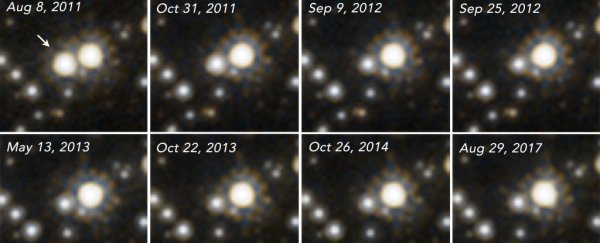Like an ancient cardigan, the Milky Way should be absolutely riddled with black holes.
According to our best estimates, there should be as many as 10 million to 1 billion stellar-mass black holes out there, drifting peacefully and quietly through the galaxy. There's just one problem when it comes to counting them: Unless they manage to snare some passing material in their gravitational field, they're basically invisible.
Invisible doesn't mean undetectable, however. For the first time, an international team of scientists has managed to detect a lone, quiescent black hole just under 5,200 light-years away. Their discovery, yet to be peer-reviewed, has been uploaded to preprint server arXiv.
How did they do it? Well, since we don't currently (and may never) have the tools to probe a black hole directly, we have to observe its effects on the space around it. For a quiescent black hole, that effect is gravitational. And because a black hole's gravitational field is so extreme, it warps and twists any light that might travel through it.
So, when something invisible magnified the light of a distant star, making it grow strangely brighter, astronomers knew there was probably a gravitational field through which it passed.
That phenomenon is called gravitational microlensing, and we've used it to identify small, dim objects that might otherwise be too difficult for our telescopes to spot. But this is the first time we've seen a lone black hole.
"We report the first unambiguous detection and mass measurement of an isolated stellar-mass black hole," wrote a team of astronomers led by Kailash Sahu of the Space Telescope Science Institute.
"We show that the lens emits no detectable light, which, along with having a mass higher than is possible for a white dwarf or neutron star, confirms its black hole nature."
Gravitational microlensing occurs when an object with a gravitational field passes almost exactly in front of a distant star.
That gravitational field causes a curvature of space-time; when light travels through the gravitational field, it follows that curvature, causing its path to effectively 'bend'. This magnifies the light and also very slightly shifts the apparent position of the distant star.
Previous microlensing events have led to the detections of exoplanets and stars that are too dim to see. Experiments set up to monitor the sky detect thousands of microlensing events every year; most of them are stars moving in front of other stars, which is not surprising, considering how many stars are out there.
On 2 June 2011, two separate microlensing surveys – the Optical Gravitational Lensing Experiment (OGLE) and Microlensing Observations in Astrophysics (MOA) – independently recorded an event that ended up peaking on July 20.
This event, named MOA-2011-BLG-191/OGLE-2011-BLG-0462 (shortened to MOA-11-191/OGLE-11-0462, because it's a mouthful), was remarkable. Not only was it unusually long, around 270 days, but it also showed unusually high magnification. Since high magnification events are sensitive to perturbations, such as might be seen from a planet orbiting the lensing object, scientists converged to take follow-up observations and conduct analyses.
Observations of the region were taken on eight separate occasions using the Hubble Space Telescope, up until 2017. Armed with that data, Sahu and his team started crunching numbers, and they found that the best fit for the data was a black hole, not a star.
In fact, they were even able to take measurements of the black hole. The changes observed in the light of the distant star allowed the team to calculate its mass and motion. The black hole, they found, has a mass about 7.1 times the mass of the Sun. That would make its event horizon around just 42 kilometers (26 miles) across.
Take a moment to marvel at that. Scientists were able to detect an invisible object less than a tenth the length of the Grand Canyon from over 5,000 light-years away by studying the changing light of a more distant star. That's freaking awesome.
And here's where it gets even cooler. The team calculated how fast that object is moving through the Milky Way: 45 kilometers (28 miles) per second. That makes it not just any old black hole but a runaway black hole.
It was probably ejected into space when its precursor star exploded in a supernova. If such a supernova explosion is lopsided, the uneven force can flick the star's collapsed core off into space, in what we call a natal kick. We've seen these stars before: White dwarf LP 40-365 and pulsar PSR J0002+6216 are two examples.
A 2019 study found that there could be millions of natally kicked black holes zooming at high speeds around the Milky Way. It would be unbelievably cool if MOA-11-191/OGLE-11-0462 is one of them.
It's possible the object might be drifting through a high-density region of space. Future work, the researchers said, could involve using sensitive X-ray telescopes to determine if the putative black hole is accreting any material from the interstellar medium around it.
In addition, future instruments could detect even more isolated stellar mass black holes. Once a population has been discovered and studied, we'll be able to use that data to learn more about MOA-11-191/OGLE-11-0462 and the black holes that inhabit the Milky Way in general.
The team's research has been submitted to The Astrophysical Journal and is available on arXiv.
